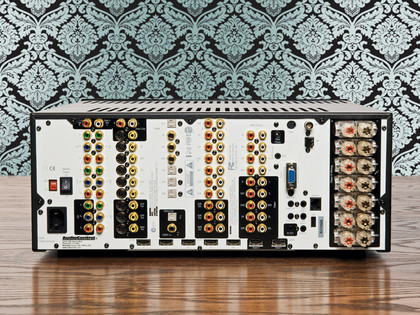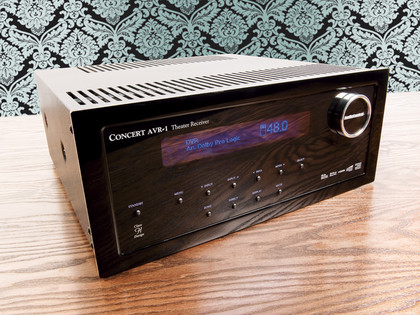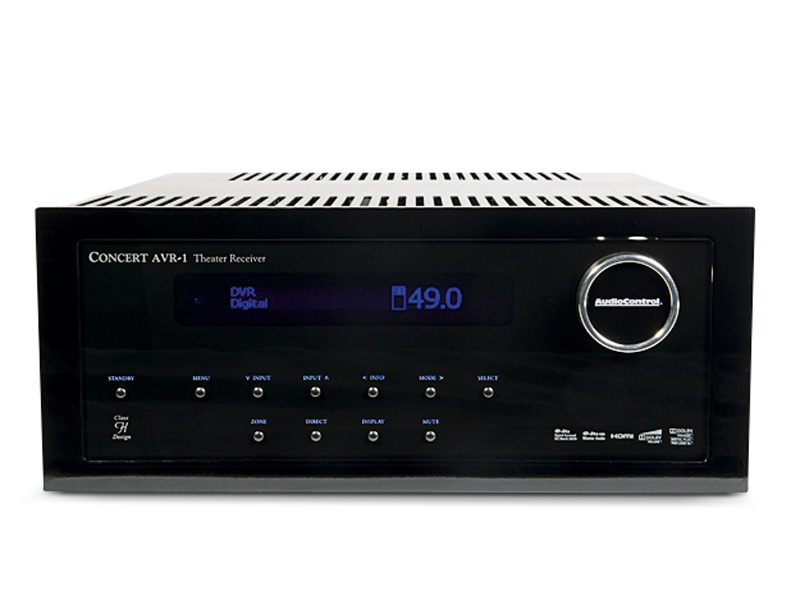TechRadar Verdict
With an unusual approach to amplifier design, the AVR-1 is an uncompromising product that suits the home installation market perfectly. We hope the issues we had are fixed soon with a firmware update
Pros
- +
Robust, potent and rewarding sound
- +
Installer-friendly
Cons
- -
Lacks features compared to Japanese super amps
- -
Remote control costs extra
Why you can trust TechRadar
You may not have heard of AudioControl, but it is a sizeable 30-year-old company and a big hit back in its native US of A. The company is probably most famous for its in-car equipment but it has a growing reputation for home theatre gear; often great value and often selected by installers for classy home cinemas.
The company's marketing and attitude is a bit loud, a bit lairy and a bit in-yer-face, but they are American so we expect that. The Concert AVR-1 is the latest flagship AV receiver – or as AudioControl like to call it, its premium Home Theater Platform. By the time it has hit UK shores, it retails for a not inconsiderable £6,000 plus a remote control.
What, no remote as standard? Correct, because AudioControl believes that the very best remote is a dedicated multi-function device such as the Philips Pronto (£1,150) for which the company supplies dedicated interface software.
At nearly £7,500 we are getting into serious territory, well above the top-end Pioneer, Denon, and Yamaha models and beginning to encroach on the bottom end of Krell, Lexicon and Anthem territory. Serious stuff.
Starting from the outside, the AVR-1 is about as subtle as a motorway pile-up. It's huge, monstrously heavy, and the cosmetics are straight out of the McIntosh bling school of design. The fascia is black glass with enough blue LEDs to read a book by at ten paces, and the dot-matrix style LCD display powers up with a full width/full height company logo like a Las Vegas slot machine.
The casework looks like an exercise in structural engineering, particularly with its rack-mount cheeks in place, and the rear panel offers speaker binding posts capable of accepting cables up to steel-shipping hawser size.

Connectivity is faultless, with a good number of pretty much every input/output you could need for the most serious AV set-up.
Sign up for breaking news, reviews, opinion, top tech deals, and more.
The features list is certainly not left wanting, with full decoding for all the regular Dolby and DTS formats over HDMI; full network access via Ethernet; USB with streaming control; 5-in 2-out HDMI sockets, and a full set of installer features. These include multizone outputs, 12V triggers, IR repeaters and RS232 integration.
There is nothing in the features set that would not be trumped by a £2K Onkyo, but AudioControl's big push is premium sound quality derived from its innovative Class H amplifier topology.
Class H amplifiers take the idea of stepped voltage rails further by offering an infinitely variable power-supply voltage. It's a complex design in terms of engineering, but it allows the power amps to run at optimum efficiency by tracking the input signal and adjusting the voltage rail output accordingly in real time.
Under idling or low volume conditions, the AVR-1 ticks over, running cool and merely sipping a few watts from your mains supply. Crank up the volume or get a big program demand such as an explosion and the power supply voltage raises instantly to ensure massive dynamic headroom.
The upshot is an amp that only draws as much current from the wall as is required, wasting very little in heat. That's green credentials. Of a sort.
Basic menu
As the Pronto and set-up mic both failed to turn up with the review sample, I had to resort to the front panel controls to run the setup; the auto-set-up feature only provides very basic filtering room EQ anyway, so I stuck to manual rather than risk using an uncalibrated mic.
Unfortunately, AudioControl's menu-driven interface is a bit clunky and I do miss the pretty-pictures and interactive GUIs of other top-notch designs.
The left-right, up-down and select keys on the front panel don't necessary drive the menus in the direction you expect, but generally set-up wasn't too painful even without the Pronto.
Let me get the bad bit out the way first by stating that our sample AVR-1 was a bit 'buggy'. It's Insect House at London Zoo buggy, in fact.
Chances are that by the time you read this many of the issues will be sorted by firmware updates, but I had a full gamut of aggro, including HDMI syncing issues, getting video from one input and audio from another, long pauses of silence after changing sources, a jumpy volume control, and occasionally no sound at all. It does make you realise just how slick the big Japanese manufacturers are when they release a complex product like a multi-function AV receiver.
Thankfully, the bugs tended to be set-up and control related, meaning that when the AVR-1 was doing its thing it really got down to business with unfettered aplomb.
The sound is effortless, extended and richly decorated with effects. I called up the opening sequence of X-Men Origins: Wolverine, which tracks Wolverine and Sabretooth through the centuries, and the score was thrust into the room with serious pace and full-throttle action. Likewise, the black-and-white homage to Saving Private Ryan was crafted with huge scale; each bullet sound thumped into my chest.
There is a solidity and focus to the AudioControl's sound that makes a lot of the competition seem slightly thin by comparison, although the offset is a smaller and more compact soundstage. With big, floor-standing speakers you can hear the power coursing through the AVR-1 as it takes a firm grip on the drivers, never sounding uncontrolled or flappy – even at silly volumes.
The crashing explosion as the cooling tower collapses towards the end of ...Wolverine let the AVR-1 show its mettle with huge scale and fabulous dynamic rush. It never once made me wince with a rough splash at the top end or an over-shrill note to a soundtrack score. It's a thoroughly smooth, solid and refined sound, and blessed every movie I tried with a real tangible presence.

Safe and sound
If the Concert AVR-1 lacks anything it is a little flair, something just occasionally edgy and reckless that would imbue some of the more overt effects with larger-than-life sparkle. It's certainly not an amp to throw caution to the wind and let rip with gay abandon, but at the same time it stoically refuses to get out of shape.
It is simply an enjoyable, detailed listen with a wide range of films. A brief sojourn with Elizabeth on Blu-ray (it's the wife's, honest) again highlighted the AVR-1's strength in its solidity and detail, although dialogue remained just a little too smooth and recessed for my taste.
Scene ambience, particularly outdoors, was somewhat smaller than ideal, but lacked little in terms of detailing. As my floorstanders are a little rolled-off towards the top end I suspect partnering different speakers would allow the AVR-1 to shine even more.
Hardcore
The Concert AVR-1 is clearly a hardcore installer product, so many of the set-up issues will be done and dusted before the end-user gets his hand on the programmed Pronto.
Its balance certainly favours up-front speakers, probably in-wall designs that can sound a bit forward due to operating in an unsealed cavity. Comparing it to top-flight models from Denon or Pioneer is a bit like comparing apples with pencil sharpeners, but its price point is deliciously nearer the Japanese consumer marques than other US exotica.
In the context of a high-end, well-appointed, fully-serviced custom installation, the AVR-1 has a lot to offer and is something of a £6,000 bargain.
Follow TechRadar Reviews on Twitter: http://twitter.com/techradarreview
